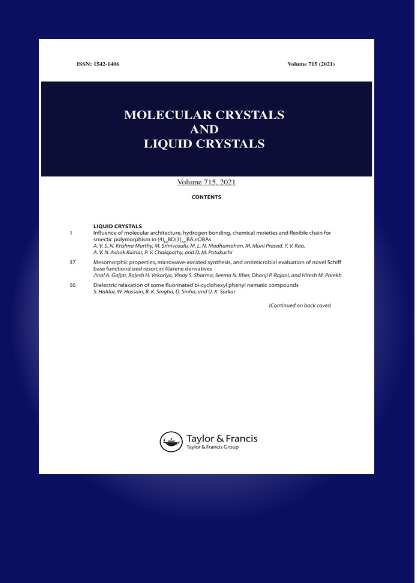Synthesis and investigation of mixed Zn–Ni spinel nanoparticles for microwave applications
IF 0.7
4区 化学
Q4 CHEMISTRY, MULTIDISCIPLINARY
引用次数: 0
Abstract
AbstractNickel ferrite solid solutions remain one of the main materials for a whole range of applications, including microwave equipment and components, the requirements for parameters and homogeneity of materials are constantly increasing. In this work, Ni1–xZnxFe2O4 nanoparticles with an average diameter of 12.5 nm were successfully synthesized by the microwave-assisted urea method. The temperature of a single-phase product formation was 400 °C, which is lower compared to more common precipitation from aqueous solution methods or solid-state route. Ni1–xZnxFe2O4 materials demonstrate high saturation magnetization and low coercive force. The magnetization changes with increasing Zn concentration and reaches the maximum at x = 0.5. Also, the increase in zinc content leads to an increase in the lattice parameters. The average size of ferrite nanoparticles synthesized by the microwave-assisted urea method is smaller compared to ferrites synthesized earlier by the co-precipitation method. Also, lower treatment temperatures provide higher stoichiometry, and homogeneity of materials while magnetization difference is negligible. These research results provide a general and effective route to synthesize other nanostructures for a variety of microwave components.Keywords: Lattice constantmagnetic propertiesNiFe2O4zinc substitutionZnFe2O4 AcknowledgmentsThe authors express their gratitude to the Armed Forces of Ukraine for providing security to perform this work. This work has become possible only because of the resilience and courage of the Ukrainian Army. The Czech Group acknowledges financial support from the project of the Ministry of Education, Youth and Sports (LM 2018116). The authors are grateful to the Center of Mossbauer Spectroscopy at G. V. Kurdyumov Institute for Metal Physics of the National Academy of Sciences of Ukraine.Disclosure statementThe authors declare that they have no known competing financial interests or personal relationships that could have appeared to influence the work reported in this article.Additional informationFundingThis work was supported in part by the NATO Science for Peace and Security Programme within the framework of the “3D Metamaterials for Energy Harvesting and Electromagnetic Sensing” project (ID SPS G6002).微波用混合锌镍尖晶石纳米颗粒的合成与研究
摘要镍铁氧体固溶体仍然是包括微波设备和元件在内的一系列应用的主要材料之一,对材料的参数和均匀性的要求也在不断提高。本文采用微波辅助尿素法制备了平均直径为12.5 nm的Ni1-xZnxFe2O4纳米颗粒。单相产物形成的温度为400°C,与水溶液法或固态法更常见的沉淀相比,这一温度较低。Ni1-xZnxFe2O4材料具有较高的饱和磁化强度和较低的矫顽力。磁化强度随Zn浓度的增加而变化,在x = 0.5时达到最大值。锌含量的增加导致晶格参数的增加。微波辅助尿素法合成的铁氧体纳米颗粒的平均尺寸比先前用共沉淀法合成的铁氧体小。此外,较低的处理温度提供较高的化学计量,材料的均匀性,而磁化差异可以忽略不计。这些研究结果为合成各种微波元件的其他纳米结构提供了一条通用而有效的途径。关键词:点阵恒磁特性nife2o4锌取代znfe2o4致谢作者感谢乌克兰武装部队为完成这项工作提供安全保障。这项工作之所以成为可能,完全是因为乌克兰军队的坚韧和勇气。捷克集团感谢教育、青年和体育部项目(LM 2018116)的财政支持。感谢乌克兰国家科学院G. V. Kurdyumov金属物理研究所穆斯堡尔光谱学研究中心。披露声明作者声明,他们没有已知的竞争经济利益或个人关系,可能会影响本文所报道的工作。这项工作得到了北约和平与安全科学计划“用于能量收集和电磁传感的3D超材料”项目(ID SPS G6002)框架内的部分支持。
本文章由计算机程序翻译,如有差异,请以英文原文为准。
求助全文
约1分钟内获得全文
求助全文
来源期刊
CiteScore
1.20
自引率
14.30%
发文量
248
审稿时长
2 months
期刊介绍:
Established in 1966, Molecular Crystals and Liquid Crystals is a world-leading journal publishing original research papers in both an experimental and theoretical nature in three areas of specialization: liquid crystals, molecular crystals, and low-dimensional solids. These cover, but are not limited to:
Liquid Crystals:
-Electro- and magneto-optical phenomena; thermodynamics; phase transitions; structure; NMR and orientation-controlled spectroscopy; theory.
Molecular Crystals:
-Spectroscopy; energy and charge transfer; solid state reactions; photo and radiation effects
Low-dimensional Solids:
-Structure, electronic, magnetic, and optical properties; transport mechanisms
The journal publishes research papers, review papers, and book reviews. In all three areas, experimental manuscripts describing both preparation and properties will be considered. Papers that describe determination of crystal structure alone are not encouraged unless some solid state forces (hydrogen bonding, charge transfer, etc.) are playing a significant role and/or some solid state properties of the materials are measured.

 求助内容:
求助内容: 应助结果提醒方式:
应助结果提醒方式:


